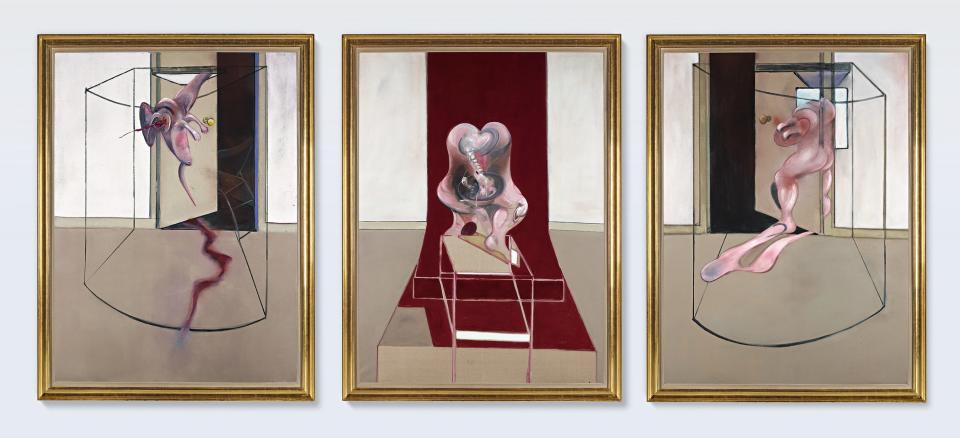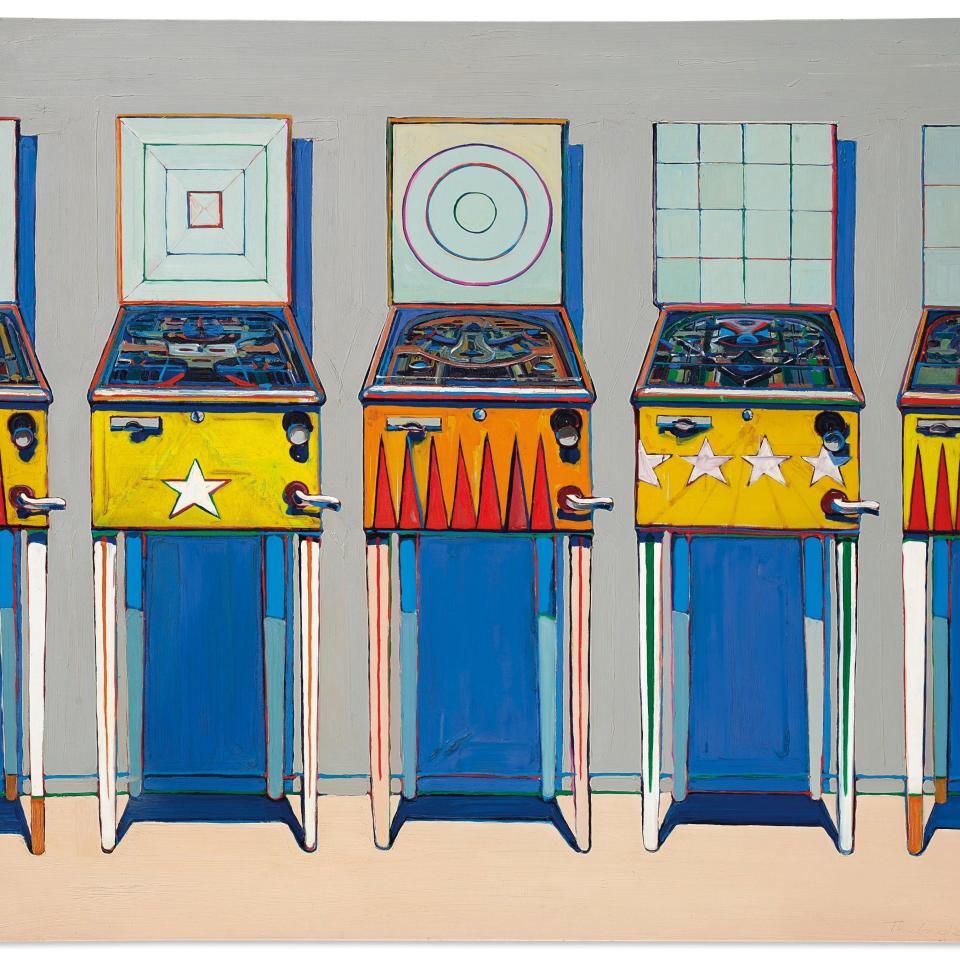Is this the future of art auctions? Sotheby’s stages a £295m ‘hybrid’ sale, without a single bidder present

The drought of high-octane art auctions came to end last night after a marathon 4.5-hour sale in which Sotheby’s sold $365 million (£294.2 million) of modern and contemporary art from a specially designed, anti-viral studio in New Bond Street.
At 11.30pm (6.30pm in New York), its chief auctioneer, Oliver Barker, took up his lonely post, ahead of three massive screens on which overseas representatives in London, New York and Hong Kong were arranged in safely distanced tiers to wave telephone bids on behalf of their clients.
High-end live auction-goers have got used to watching telephone bids made by the world’s wealthy who want to protect their anonymity. But there are still a few (perhaps 40 or so) who like the attention, and their dealers, who in pre-lockdown times would show up in person to bid.

Last night, though, there were no bidders or observers physically present. Sotheby’s described it as a ‘live’ sale because there was an auctioneer present in real time, but it was actually a hybrid construct to overcome the price limits experienced in completely impersonal online-only sales, which rarely exceed 1 million dollars.
“Sotheby’s will revolutionise the art auction,” the house had promised. “The auction of the future is here,” it ventured.
A combination of online and phone bidding - without any physical bidders - made it different to anything seen before. The phone buyers far outnumbered those online, who claimed only a handful of lots; nevertheless Sotheby’s did make its biggest-ever sale of a picture to an online bidder last night - a vivid ink and oilstick drawing on paper by Jean-Michel Basquiat which sold for $15.2m.

The construct may have had surreal appeal at first, but even the best-dressed Sotheby’s employees manning the phones began to look like restricted, animated puppets after a while. The action bore no comparison with the glamorous, show-off, multi-million-dollar live auction sales that the market had taken for granted.
And it all took too long - mostly due to the telephone bidders. At this level, where there is competition, the auctioneer gives bidders plenty of time to decide whether to make another offer or not.
However, it was effective. As one arts journalist tweeted, ‘who needs Glastonbury when you’ve got Sotheby’s?’. And it was what the market had been waiting for. For Sotheby’s, it exceeded its last live sales in these categories, staged in London in February, that made £142 million, and was not too far short of its equivalent live sales in New York last November of $469 million.

Because collectors have been starved of supply, there was a lot of confidence going into the sale, said dealer Brett Gorvy, a former head of contemporary art at Christie’s, who noted how collectors had visited New York, some by private jet, to view the sale in person.
On the menu were some choice pieces that had been consigned for sale before the pandemic struck. The collection of the late Virginia Williams, a dealer who made a point of supporting female artists, had received a financial guarantee from Sotheby’s.
Her all-American cast from the post-war years was 100% sold for $66.5 million, led by a $9 million painting by Jackson Pollock’s wife, Lee Krasner, and a panoramic painting by Helen Frankenthaler, a second wave Abstract Expressionist, that fetched a record $7.9 million.
The biggest catch of the evening was a large triptych by Francis Bacon being sold by Norwegian octogenarian billionaire, Hans Rasmus Astrup, with a $60-80 million estimate. Guaranteed by Sotheby’s, its confidence was justified when two bidders, one of them online from China, battled it out before it sold for $84.6 million.
Ten works from the collection of the late Harry ‘Hunk’ Anderson, a catering magnate, art lover and generous museum benefactor, included American post-war classics by the likes of Clyfford Still and Richard Diebenkorn and was also 100% sold - these for $66.3 million.

Amongst the younger generation of artists was Hong Kong-born, New York-based artist Matthew Wong, who tragically killed himself last year. A firework display of global bidding erupted for his intricately drawn landscape, The Realm of Appearances, taking the price from $60,000 to a thumping new record $1.8 million.
In the lower price echelon of Impressionist and Modern art, the main stars were Latin American female surrealists such as Leonor Fini, Alice Rahon and Remedios Varo who all set record prices, though their male counterpart, Wifredo Lam, outshone them all with a $9.6 million record. By the end of the sale, only five out of 74 lots had gone unsold.
Perhaps the most interested observer last night was Christie’s, which will stage a rival sale, estimated at $336 million, on July 10. Christie’s has lagged far behind its rivals in the lockdown online-only sales these last three months, so will have something to prove.

Like Sotheby’s, its auction will be live and global in that it will be staged consecutively in four different locations - Hong Kong, Paris, London and New York - with a live auctioneer in each location taking phone bids.
As things stand, there may even be bidders in the auction rooms in Paris and Hong Kong. Christie’s promises it will be worth watching. Its president, Jussi Pylkkänen, thinks more people will view this sale online than any other – even the 2017 sale with the $450 million Leonardo.
It will certainly be held at a more hospitable time – maybe four hours long, but in the middle of the day for Europeans. Matthew Wong will star again in Hong Kong; France’s most expensive artists, Jean Dubuffet (€3-5 million) and Pierre Soulages (€2.5-3.5 million) as he nears his 100th birthday, in Paris; and a spicy concoction from Impressionism (Camille Pissarro), Surrealism (a Magritte at £9.5 million), and German 1980s neo-expressionism (an early Baselitz at £6.5 million), to Britain’s most sought after young painter, Cecily Brown (£6 million), in London.

But the real show-stoppers are reserved for the final leg, staged in New York. The modern section is led by one of a series of paintings by Picasso inspired by Delacroix’ Femmes d’Alger with a $25 million estimate. One large example from the series made $174 million in 2015 selling reportedly to the former Qatari Prime Minister, Hamad bin Jassim bin Jaber Al Thani.
Although Sotheby’s describes the seller of this smaller version as a ‘distinguished private collector’, trade sources say it belongs to Hong Kong businessman, Joseph Lau, who also sold David Hockney’s ‘Splash’ last year for £23.1 million.
It is in the post-war American art department, however, that the strength and backbone of the Christie’s sale resides. Expected to fetch over $30 million each are a voluptuous Ben Day dot female nude by pop artist, Roy Lichtenstein, and an abstract ‘zip’ painting by the Abstract Expressionist Barnett Newman.
Also in the eight-figure bracket is a large painting of pin-ball machines by West Coast painter, Wayne Thiebaud, who, like Soulages, is approaching his 100th birthday. The painting was last sold in 1981 for $143,000 and is now expected to break the artist’s record at $18 to $25 million.
Like most of the works in this rarefied price bracket, it has been covered by a confident guarantee either from Christie’s or a third party – so will sell.
With Sotheby’s having now broken the ice, the upper end of the art market looks at last like it will have something to celebrate.
Sign up for the Telegraph Luxury newsletter for your weekly dose of exquisite taste and expert opinion.


